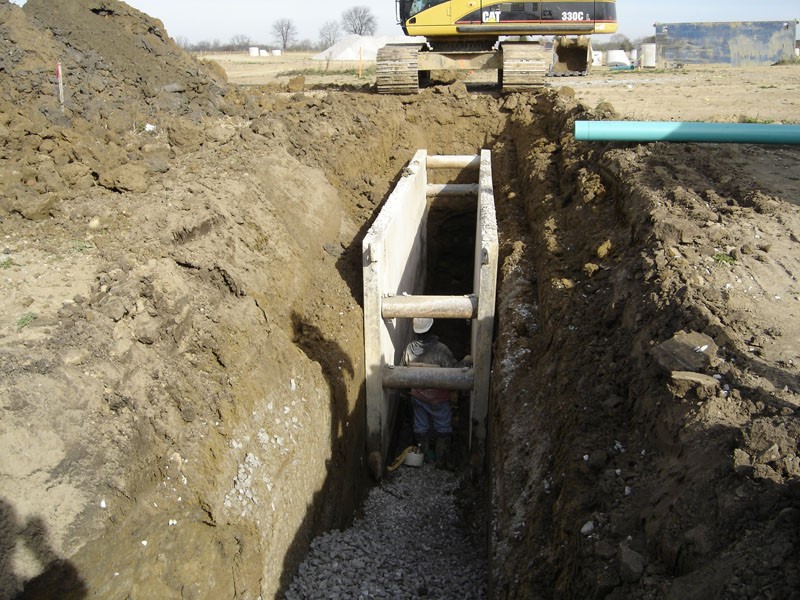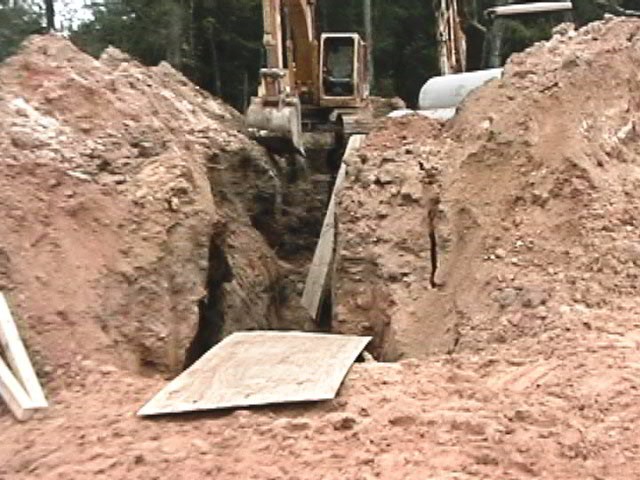Contents
Keeping Cool
INSafe's Role in Workplace Safety and Health
Trench Safety
Dig It
Safety Calendar
Keeping Cool
Millions of U.S. workers are exposed to environmental heat in the workplace. Although illness from exposure to heat is preventable, thousands of workers become sick from occupational heat exposure. Some severe cases even turn fatal. Outdoor workers are most at risk for heat-related illness, but working indoors in hot environments can be just as dangerous.
The three primary types of heat-related illness are:
- Heat Cramps - Painful muscle cramps and spasms usually in legs and abdomen that are often accompanied by heavy sweating. First aid for a worker experiencing these symptoms includes maintaining firm pressure on or massaging the cramping muscles and moving the worker to a cool area to rest. Heat cramps are a good warning sign that a worker is getting too hot.
- Heat Exhaustion – Usually defined by heavy sweating, weakness or tiredness, pale or clammy skin, rapid pulse, muscle cramps, dizziness, nausea, headache, or fainting. Workers experiencing heat exhaustion should be moved to a cool, preferably air conditioned, area and given cool water to sip. Clothes should be loosened and cool rags or water should be applied to the skin. If the ill worker is vomiting repeatedly or if symptoms worsen within an hour, seek medical attention immediately. Heat exhaustion can quickly progress to heat stroke if left unaddressed.
- Heat Stroke – The most severe form of heat illness. Symptoms include a throbbing headache, confusion, nausea, dizziness, a body temperature above 103°F, hot, red, dry or damp skin, rapid pulse, fainting, and loss of consciousness. If a worker is experiencing these symptoms, seek medical attention immediately and move the worker to a cool, preferably air conditioned, area. If treatment is delayed, heat stroke can quickly turn fatal.
50-70% of outdoor heat-related fatalities occur in the first few days of exposure to warm or hot environments. Lack of acclimatization is a major risk factor for fatal outcomes. The body requires time to acclimatize, or gradually build a tolerance, to the heat.
Most heat-related illnesses affect workers who do strenuous physical activity. When workers engage in intense work, their bodies create heat. This metabolic heat, when combined with environmental heat, can cause the workers’ core temperature to rise to dangerous levels.
To prevent a hazardous combination of environmental and metabolic heat, employers must be aware of the employees’ activity level. Workload can be classified as light, moderate, heavy, or very heavy. Heavy and very heavy work carries the highest risk of heat-related illness.
- Light: sitting or standing with minimal arm and leg work.
- Moderate: Continuous modest intensity, such as light pushing/pulling or normal walking.
- Heavy: Intense upper body work such as carrying loads or sawing.
- Very heavy: Intense activity at an almost maximum pace.
Estimating each worker’s workload is important. Workers who are overweight or obese might produce more metabolic heat than other workers who perform the same task. These workers should be given frequent rest breaks, and work should be scheduled in the cooler part of the day.
If you have any questions about heat safety, contact the Indiana Department of Labor’s INSafe program by phone at (317) 232-2688 or by e-mail at insafe@dol.in.gov . INSafe’s consultants can help your company develop safety and health plans to keep your workers safe this summer.
INSafe's Role in Workplace Safety and Health
Workplace safety and health achievements are a collaborative effort. From conception to implementation, it takes involvement and dedication from both employees and management to truly make a program successful. Although many elements of safety in the workplace seem like common sense, training, planning, and implementation of safety and health programs require much more than a quick pencil-whip. Sometimes, what seems like a simple process can have hidden dangers. That is where INSafe can help.
INSafe, a division of the Indiana Department of Labor, is a team of workplace safety and health professionals that can assist Hoosier employers with their safety and health programs. Rather than taking a reactive, punitive approach to safety like one would typically see with an IOSHA investigation, employers invite INSafe consultants to help identify hazards, answer questions about OSHA standards, and assist in training their teams. While INSafe and IOSHA share the goal of ensuring safety and health of Hoosiers in the workplace, our methodologies are completely different.
IOSHA plays the enforcement role in workplace safety and health. IOSHA inspectors will contact or visit a business with the duty of uncovering hazards that may injure employees. The inspector will walk the facility and/or review the available programs and documentation to ensure all applicable OSHA standards are met. Visits from IOSHA often result in citations which carry a civil monetary penalty (a fine).
INSafe consultants are invited in by employers who are interested in being proactive with safety. While INSafe consultants may walk a jobsite and/or review programs just as an IOSHA inspector would, INSafe consultants do not generate citations or monetary penalties. Rather, the consultant will work with employers to explain the best methods of addressing any hazards and ensuring the safety and health of their employees. INSafe’s services are offered at no cost to the employer, and our findings are kept completely confidential. We will not share an employer’s information with IOSHA, the media, competing companies, or anyone else.
Early intervention by INSafe consultants can help bolster an employer’s safety and health program by:
- Recognizing hazardous factors
- Increasing safety awareness
- Implementing a comprehensive employee safety and health plan
- Helping employees increase safety awareness
- Boost employee morale through a positive safety culture
- Noise and air quality monitoring in the workplace.
For more information about INSafe and its services, please visit www.in.gov/dol/safety-and-health-consultation/insafe-home/ .
Trench Safety
Anytime excavation work is done, there is a potential for cave-in or collapse of the excavation walls. A cubic yard of soil can weigh from one to one-and-a-half tons, and an excavation wall collapse can occur in less than one second. Utilizing a proper cave-in protection system is imperative.
Unless the excavation is made entirely in stable rock, employees must be protected from cave-ins via some type of protective system if an excavation is five feet deep or deeper.
A competent person must perform a soil analysis using at least one manual and visual analysis to classify the soil type so that a proper protective system can be installed based on the soil type, conditions, depth, and work involved. Soils are classified as either type A (cohesive clay type soils), type B (silt or loam type soil), and type C (sandy soil). Take a look at our YouTube video “Good Dirt” for more information about testing for different soil types.
There are various forms of protective systems which can be used to protect employees from trench collapses or cave-ins. These include sloping and benching the soil, using timber or aluminum hydraulic shoring, or sheet piling and bracing. Shields systems (trench boxes) can also be used, as well as other protective system designs by a registered professional engineer.
Other requirements when performing excavation operations.
- Call 811 before you dig! Underground utilities such as water, sewer, fuel, electric, telephone, cable, and fiber optic must be located prior to opening an excavation.
- Conduct daily inspections of the excavation for hazardous conditions.
- Ensure a means of egress is provided from trench excavations 4 foot or more in depth.
- Do not work under loads handled by lifting or digging equipment.
- Take adequate precautions to prevent water from accumulating in trenches or excavations such as pumps to remove the water.
- Use support systems such as shoring, bracing, underpinning when the stability of adjoining structures, walls, or buildings is compromised and never undermine sidewalks, pavement, or footings unless they are supported from collapse.
- Keep all excavated material at least two feet from the edge of the excavation and scale back any loose rock, soil, and other material from rolling into the excavation
- Know the OSHA regulations associated with excavation operations.


Dig It
Safety Calendar
September

